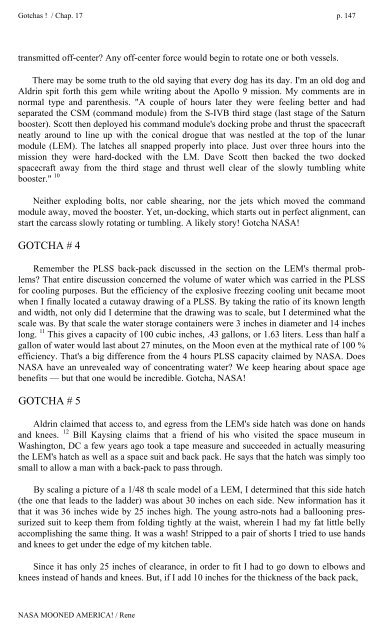Rene-NASA-Mooned-America
Rene-NASA-Mooned-America
Rene-NASA-Mooned-America
Create successful ePaper yourself
Turn your PDF publications into a flip-book with our unique Google optimized e-Paper software.
Gotchas ! / Chap. 17 p. 147<br />
transmitted off-center Any off-center force would begin to rotate one or both vessels.<br />
There may be some truth to the old saying that every dog has its day. I'm an old dog and<br />
Aldrin spit forth this gem while writing about the Apollo 9 mission. My comments are in<br />
normal type and parenthesis. "A couple of hours later they were feeling better and had<br />
separated the CSM (command module) from the S-IVB third stage (last stage of the Saturn<br />
booster). Scott then deployed his command module's docking probe and thrust the spacecraft<br />
neatly around to line up with the conical drogue that was nestled at the top of the lunar<br />
module (LEM). The latches all snapped properly into place. Just over three hours into the<br />
mission they were hard-docked with the LM. Dave Scott then backed the two docked<br />
spacecraft away from the third stage and thrust well clear of the slowly tumbling white<br />
booster." 10<br />
Neither exploding bolts, nor cable shearing, nor the jets which moved the command<br />
module away, moved the booster. Yet, un-docking, which starts out in perfect alignment, can<br />
start the carcass slowly rotating or tumbling. A likely story! Gotcha <strong>NASA</strong>!<br />
GOTCHA # 4<br />
Remember the PLSS back-pack discussed in the section on the LEM's thermal problems<br />
That entire discussion concerned the volume of water which was carried in the PLSS<br />
for cooling purposes. But the efficiency of the explosive freezing cooling unit became moot<br />
when I finally located a cutaway drawing of a PLSS. By taking the ratio of its known length<br />
and width, not only did I determine that the drawing was to scale, but I determined what the<br />
scale was. By that scale the water storage containers were 3 inches in diameter and 14 inches<br />
long. 11 This gives a capacity of 100 cubic inches, .43 gallons, or 1.63 liters. Less than half a<br />
gallon of water would last about 27 minutes, on the Moon even at the mythical rate of 100 %<br />
efficiency. That's a big difference from the 4 hours PLSS capacity claimed by <strong>NASA</strong>. Does<br />
<strong>NASA</strong> have an unrevealed way of concentrating water We keep hearing about space age<br />
benefits — but that one would be incredible. Gotcha, <strong>NASA</strong>!<br />
GOTCHA # 5<br />
Aldrin claimed that access to, and egress from the LEM's side hatch was done on hands<br />
and knees. 12 Bill Kaysing claims that a friend of his who visited the space museum in<br />
Washington, DC a few years ago took a tape measure and succeeded in actually measuring<br />
the LEM's hatch as well as a space suit and back pack. He says that the hatch was simply too<br />
small to allow a man with a back-pack to pass through.<br />
By scaling a picture of a 1/48 th scale model of a LEM, I determined that this side hatch<br />
(the one that leads to the ladder) was about 30 inches on each side. New information has it<br />
that it was 36 inches wide by 25 inches high. The young astro-nots had a ballooning pressurized<br />
suit to keep them from folding tightly at the waist, wherein I had my fat little belly<br />
accomplishing the same thing. It was a wash! Stripped to a pair of shorts I tried to use hands<br />
and knees to get under the edge of my kitchen table.<br />
Since it has only 25 inches of clearance, in order to fit I had to go down to elbows and<br />
knees instead of hands and knees. But, if I add 10 inches for the thickness of the back pack,<br />
<strong>NASA</strong> MOONED AMERICA! / <strong>Rene</strong>


